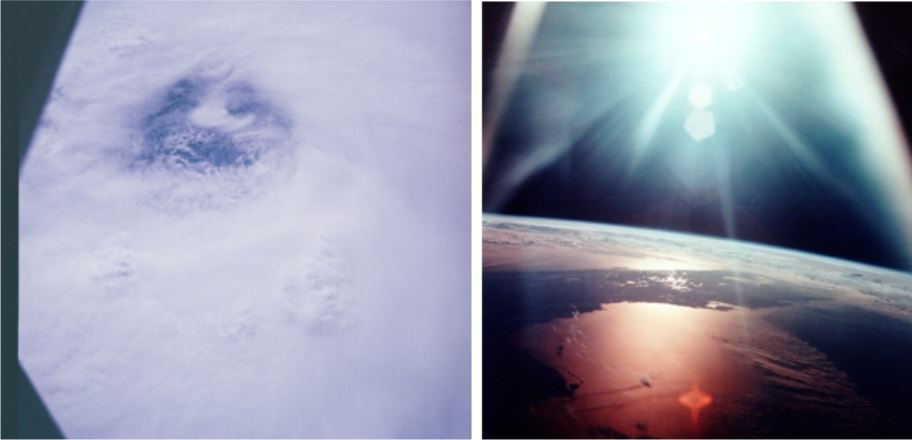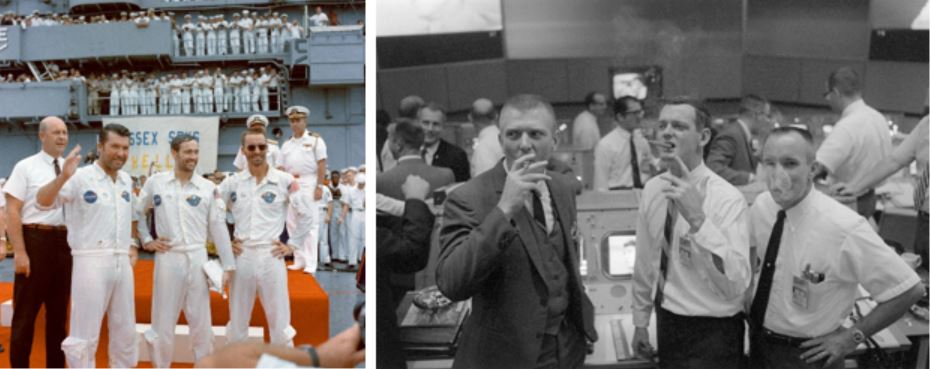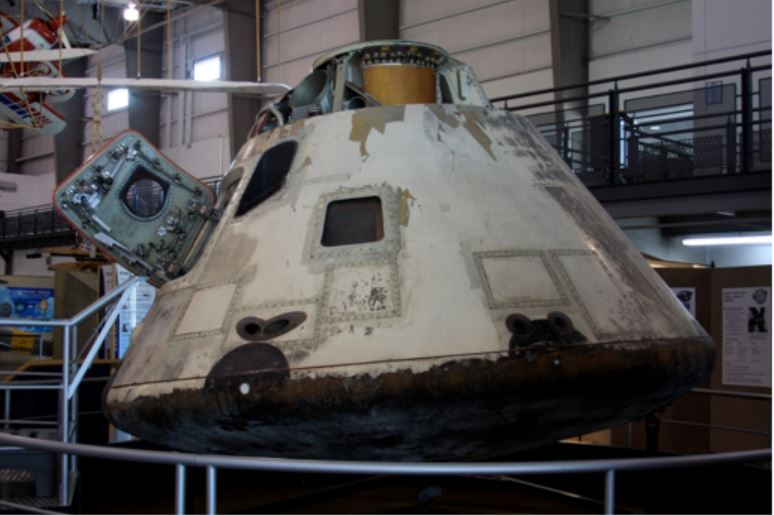Apollo 7, with astronauts Walter M. Schirra, Jr., Donn F. Eisele, and R. Walter Cunningham aboard, splashed down on October 22, 1968, ending a highly successful engineering test flight. The landing occurred in the Atlantic Ocean, southeast of Bermuda. All mission objectives were accomplished, and with a duration of nearly 11 days, the flight proved the ability of the spacecraft and crew to complete an 8-day lunar landing mission. All spacecraft systems performed essentially as expected, including the all-important Space Propulsion System (SPS) engine, critical on future missions to place crews into and return them from lunar orbit. Apollo 7 accomplished many firsts, including the first 3-person American spaceflight, the first live TV downlink from an American spacecraft, the first Saturn rocket to launch a crew into space, and the first time hot food was available to a crew in space.
During the last three days of the mission, Schirra, Eisele, and Cunningham completed two more of the eight planned tests of the SPS. The sixth burn on Flight Day (FD) 9 was the second minimum duration burn, lasting only half a second, to validate how closely the guidance and navigation system can control a very short duration burn. The seventh burn on FD10 lasted just under 8 seconds and placed the spacecraft in the proper position for reentry the next day.
The Apollo 7 crew treated viewers to two more live TV broadcasts. The sixth event on FD9 was an operational test of the camera, showing a static view of their activities inside the capsule. At the end of the broadcast, the crew proudly showed off their 9-day-old beards. The next day, they turned on the TV camera for the seventh and final broadcast of the mission. Viewers saw the crew going about their work at their crew stations, the astronauts again showing off their facial hair. They also narrated how they perform Earth obs photography through the spacecraft’s five windows, adding that they can easily see jet contrails sometimes extending for hundreds of miles and looking at Lake Pontchatrain in Louisiana the bridge was very visible. They signed off this last broadcast with a cue card that said “As the Sun Sinks Slowly in the West.”
In other activities during the last three mission days, the crew completed the second passive thermal test, putting their spacecraft into a slow end-over-end maneuver. During the 45-minute test, the spacecraft completed a full rotation every 20 minutes. The crew wanted to expose as much of the onboard film as possible, so they requested that Mission Control send up additional Earth observation targets for them to image. One notable target imaged was Typhoon Gloria that was churning in the western Pacific Ocean.
In preparation for reentry, Schirra put on his spacesuit and strapped himself into the crew couch with no gloves or helmet on. This was his preferred approach for the reentry, during which increasing pressure inside the spacecraft, from the orbital pressure of 5 pounds per square inch (psi) rapidly increasing to 14.7 psi at splashdown, might cause problems with their ears. With the nasal congestion from their colds, the crew might have difficulty clearing their ears if they were wearing helmets, and Schirra was concerned about ruptured eardrums. After much discussion, Mission Control reluctantly agreed that they could reenter with their helmets off.
During Apollo 7’s 163rd revolution around the Earth, about 500 miles east of Hawaii, the crew fired the spacecraft’s SPS for the eighth and final time for just under 12 seconds to begin their reentry. Two minutes later, the Command Module (CM) separated from the Service Module, and with its heatshield facing in the direction of flight, began to encounter the upper layers of the Earth’s atmosphere. From the friction of reentry, a sheath of ionized gases formed around the capsule, temporarily blocking radio communications with the crew, who experienced about 3-gs, or three times the force of Earth’s gravity, during the rapid deceleration. A drogue chute deployed at 50,000 feet altitude to further slow the craft down, followed by the three main parachutes deploying at 20,000 feet. Apollo 7 splashed down in a light rain at a speed of 22 miles per hour, about 2 miles from the targeted landing point and 8 miles from the prime recovery ship the aircraft carrier USS Essex. Total flight time was 260 hours and 9 minutes. The capsule initially assumed a nose down orientation, but flotation bags inflated to right it to a nose up position. Recovery swimmers soon attached a flotation collar around the capsule. Within a few minutes the astronauts emerged one by one from the capsule and were hoisted aboard the prime recovery helicopter and ferried to the deck of the Essex where the ship’s captain and hundreds of cheering sailors greeted them. They were whisked below decks for showers and a medical exam. President Lyndon B. Johnson telephoned to congratulate them saying, “We here in the capital, and all over this country and the world are so very proud of you this morning.”
The U.S. Navy flew the Apollo 7 crew back to the Kennedy Space Center the day after splashdown, where they spent several days debriefing managers and engineers about all aspects of their successful mission. They returned to Houston’s Ellington Air Force Base on October 26, where they were greeted by a large crowd of media and well-wishers, and they were reunited with their families. Navy personnel hoisted the Apollo 7 spacecraft aboard the Essex about an hour after they recovered the astronauts. They offloaded the capsule from the Essex once it reached the Norfolk Naval Air Station in Virginia. From there, it was flown to California and returned to its manufacturer, North American Rockwell Space Division in Downey, for postflight inspection. The Apollo 7 CM is currently on display at the Frontiers of Flight Museum in Dallas, Texas.
In summarizing the mission, General Samuel C. Phillips, Director of the Apollo Program Office at NASA Headquarters, declared that Apollo 7 “accomplished 101%” of its planned objectives. He added that much work still remained before NASA decided to send Apollo 8 on a lunar orbit mission, a decision formally announced in November 1968. The success of Apollo 7 gave the nation confidence to be able to meet President Kennedy’s commitment of landing a man on the Moon before the end of the decade.































